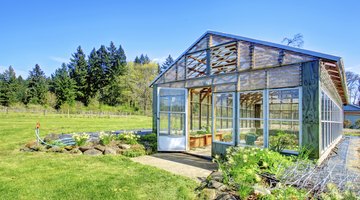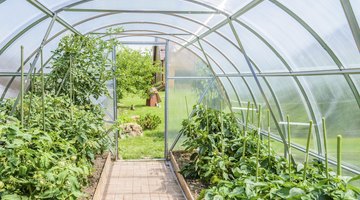Hothouse vs. Greenhouse
Some people use the terms greenhouse and hothouse interchangeably to refer to a glass or plastic building used to grow plants, but there is one significant difference between the two. Greenhouses are warmed only by the sun, while hothouses are heated by artificial sources.

Both take advantage of the sun's rays to provide plants with the light they need to thrive.
Region and Climate

Where you live, and your climate, dictate whether a greenhouse or hothouse is best for you. In warm climates, where winters are mild, a greenhouse can typically provide the protection your plants need from the cold. In colder climates, where temperatures plummet below freezing each winter, you plants will need supplemental heat during the fall and winter to maintain the temperatures they require to thrive. While those in the cooler climates may refer to their structure as a greenhouse, if it has supplemental heating, it is technically a hothouse.
Year-Round or Seasonal Use

How you plan to use your greenhouse or hothouse also affects which is right for you. If you intend to use it to start seedlings in the late spring, or grow lush annuals in summer, your building will typically get enough heat from the sun and won't require heating, making a greenhouse a logical choice. But if you intend to use it all year-round, you may need supplemental heating in winter, making a hothouse a better alternative.
Type of Plants

Root vegetables and leafy vegetables can often be grown in an unheated greenhouse all year, even in cold climates. Because these plants thrive in cool weather and are not damaged by freezing weather, they do not need high temperatures. But if you plan to grow lush, tropical plants or warm-season annual vegetables, like cucumbers (Cucumis sativus) and summer squash (Cucurbita pepo), during the winter, a heated hothouse is the answer in all but the warmest climates.
Two in One

A greenhouse and hothouse do not need to be separate structures. By equipping your greenhouse with a source of supplemental heat, you can transform it into a hothouse. That means you can use your greenhouse and heat it with the rays of the sun during the spring and summer, and add supplemental heat in fall and winter to create a cozy hothouse. Whether you choose to call it a greenhouse or a hothouse doesn't really matter as long as you provide your plants with the temperatures they need to thrive.
The Drip Cap
- Some people use the terms greenhouse and hothouse interchangeably to refer to a glass or plastic building used to grow plants, but there is one significant difference between the two.
- In colder climates, where temperatures plummet below freezing each winter, you plants will need supplemental heat during the fall and winter to maintain the temperatures they require to thrive.
- While those in the cooler climates may refer to their structure as a greenhouse, if it has supplemental heating, it is technically a hothouse.
- If you intend to use it to start seedlings in the late spring, or grow lush annuals in summer, your building will typically get enough heat from the sun and won't require heating, making a greenhouse a logical choice.
References
- Merriam-Webster: Greenhouse
- Merriam-Webster: Hothouse
- Cornell University Growing Guide: Cucumbers
- Cornell University Growing Guide: Summer Squash
- The Winter Harvest Handbook: Year-Round Vegetable Production Using Deep-Organic Techniques and Unheated Greenhouses; Eliot Coleman
Writer Bio
Nannette Richford is an avid gardener, teacher and nature enthusiast with more than four years' experience in online writing. Richford holds a Bachelor of Science in secondary education from the University of Maine Orono and certifications in teaching 7-12 English, K-8 General Elementary and Birth to age 5.
Photo Credits
- irina88w/iStock/Getty Images
- irina88w/iStock/Getty Images
- alisbalb/iStock/Getty Images
- Bruskov/iStock/Getty Images
- amanaimagesRF/amana images/Getty Images
- nanoqfu/iStock/Getty Images
More Articles



